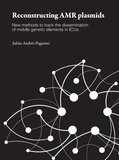Reconstructing AMR plasmids
New methods to track the dissemination of mobile genetic elements in ICUs

Paganini, Julian
- Promoter:
- Prof.dr. R.J.L. (Rob) Willems
- Co-promoter:
- Dr. A.C. (Anita) Schürch & dr. N.L. (Nienke) Plantinga
- Research group:
- Willems
- Date:
- September 27, 2023
- Time:
- 12:15 h
Summary
Antimicrobial resistance (AMR) is a pressing global concern, posing a significant threat to human health worldwide. Each year, the incidence of infections caused by resistant bacteria continues to rise, imposing a significant challenge for healthcare professionals. Genes that confer resistance to antimicrobials are frequently encoded by plasmids, extra-chromosomal mobile genetic elements that can be horizontally disseminated across bacteria by diverse mechanisms. Multiple studies suggest that plasmids are essential drivers of the spread of resistance within diverse ecological niches. Consequently, accurate plasmid identification and tracking are necessary to better understand the mechanisms that drive AMR dissemination. The development of next-generation sequencing (NGS) platforms has allowed the high-throughput study of bacterial genomes with an unprecedented level of accuracy. Nevertheless, due to the frequent occurrence of large repeated elements, bacterial genomes are often fragmented in hundreds of smaller DNA sequences (contigs) of unclear origin (plasmid or chromosome). Consequently, determining the exact sequence of plasmids is challenging. This study presents a novel two-step computational method for accurately reconstructing AMR-plasmids from bacterial NGS data. In the first step, contigs are classified as chromosomes or plasmids using an ensemble of binary classification tools called "plasmidEC." In the second step, plasmid-derived contigs are binned into individual plasmids using "gplas", a tool that leverages sequencing coverage and assembly graph connectivity. We proved that this method outperforms other existing plasmid-reconstruction tools, when tested in more than 70 different bacterial species. Furthermore, employing plasmidEC and gplas, we traced the dissemination of a tobramycin-resistance-carrying element among diverse Escherichia coli isolates sourced from patients admitted to intensive care units.